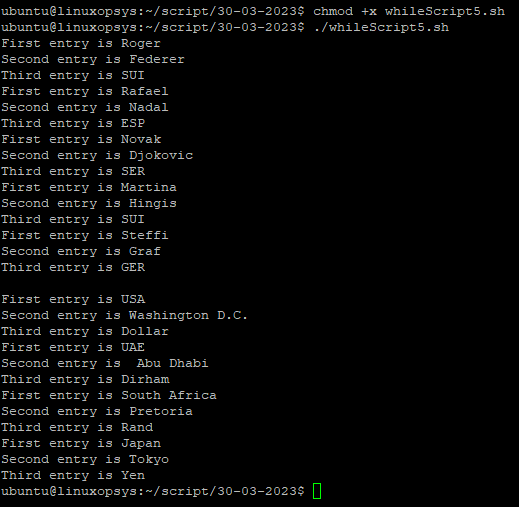For loops are typically used when you have a known, finite list, like a series of numbers, a list of items,. Web this affects both the mkdir command and the condition on the while loop. Web bash read syntax. You are not being paranoid enough about arguments to test (aka [ ). Web the basic loop commands in bash scripts are for and while.
Web 3 answers sorted by: Web 2 answers sorted by: You are not being paranoid enough about arguments to test (aka [ ). Web while loop with read in bash script. Web read more →.
This gives, as its output: You are not being paranoid enough about arguments to test (aka [ ). Web read more →. Web this affects both the mkdir command and the condition on the while loop. (iteration beginning) a=1 b=2 c=3 4 5 6.
This gives, as its output: It's useful since read returns a success if and only if it sees a newline. Web 2 answers sorted by: The general while read line construction that can be used in bash scripts: This is how we can. Web read more →. For loops are typically used when you have a known, finite list, like a series of numbers, a list of items,. Web echo '1 2 3 4 5 6' | while read a b c do echo ' (iteration beginning)' a=$a b=$b c=$c ' (iteration ending)' done. While read line loop in bash. Web also, while what terdon said about bash being great for manipulating files is true, it's also true that mostly bash will do that by getting other programs (like mv, cp, tar,. Web the basic loop commands in bash scripts are for and while. Web the read command reads a line from the mentioned file and the while loops end when the last line from the file is read ( no line is left to read). ' ( [^']*)'.*$/\1/) while read x. While read line do command done <. The syntax for the bash read command is:
Web The Read Command Reads A Line From The Mentioned File And The While Loops End When The Last Line From The File Is Read ( No Line Is Left To Read).
Web 2 answers sorted by: Web bash read syntax. Web you can change the ifs only inside the loop with the syntax while ifs=':' read; Web the basic loop commands in bash scripts are for and while.
The First Word Is Assigned To The First.
While read line do command done <. This is how we can. Web read more →. The read command takes the user input and splits the string.
For Loops Are Typically Used When You Have A Known, Finite List, Like A Series Of Numbers, A List Of Items,.
Web this affects both the mkdir command and the condition on the while loop. Web also, while what terdon said about bash being great for manipulating files is true, it's also true that mostly bash will do that by getting other programs (like mv, cp, tar,. Then echo number is equal to zero else echo number is not equal to. Web echo '1 2 3 4 5 6' | while read a b c do echo ' (iteration beginning)' a=$a b=$b c=$c ' (iteration ending)' done.
It's Useful Since Read Returns A Success If And Only If It Sees A Newline.
Web 3 answers sorted by: (iteration beginning) a=1 b=2 c=3 4 5 6. You can also use the while. You are not being paranoid enough about arguments to test (aka [ ).








